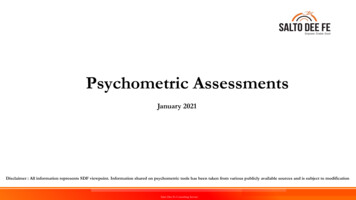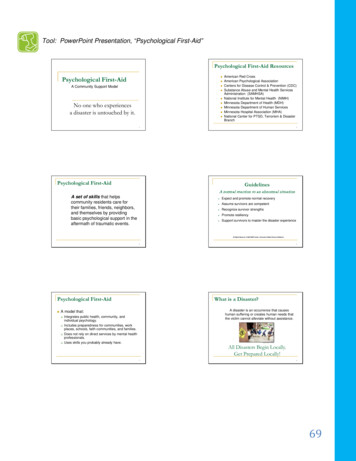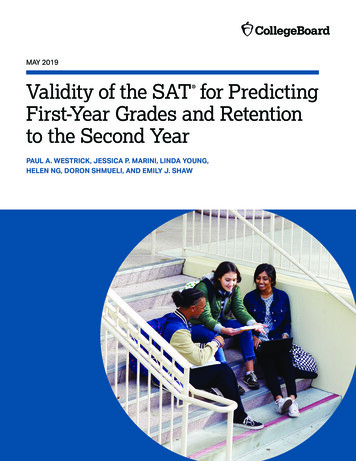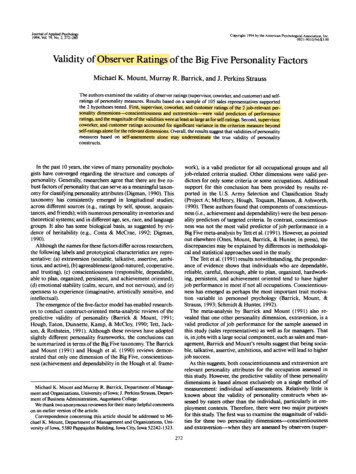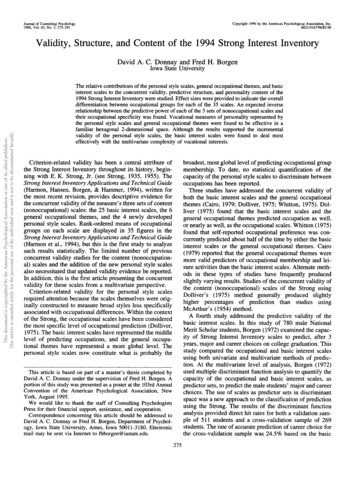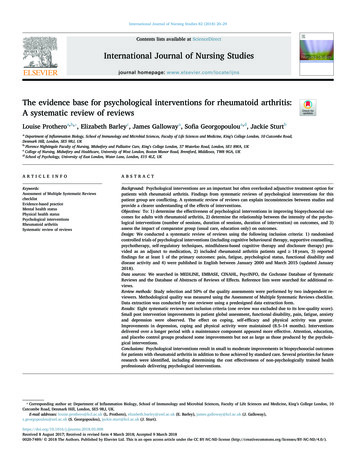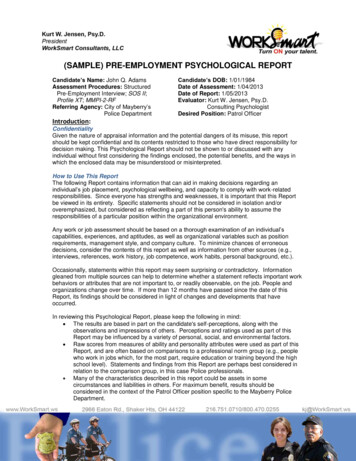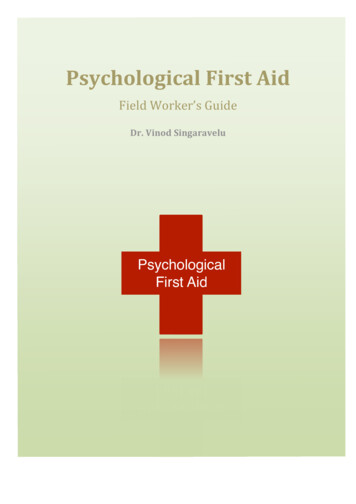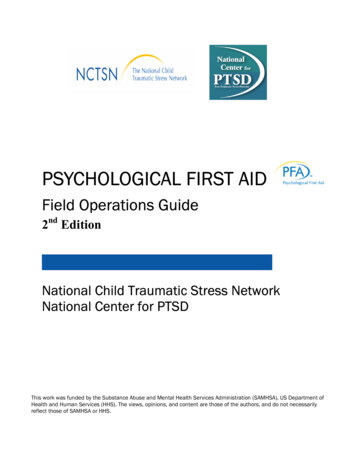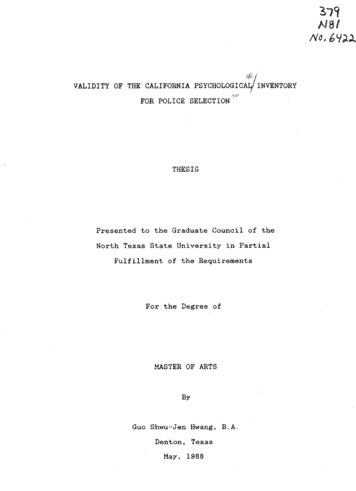
Transcription
NO,6VALIDITY OF THE CALIFORNIA PSYCHOLOGICAL/ INVENTORYFOR POLICE SELECTIONTHESISPresented to the Graduate Council of theNorth Texas State University in PartialFulfillment of the RequirementsFor the Degree ofMASTER OF ARTSByGuo Shwu-Jen Hwang, B.A.Denton, TexasMay, 1988
Hwang,Guo Shwu-Jen, Validity of the CaliforniaPsychological Inventory for Police Selection.Arts(Industrial Psychology),references,May,1988,Master of49 pp., 10 tables,47 titles.The study examined the validity of using the CaliforniaPsychological Inventory (CPI) as a tool for policeselection.The mean CPI profile of 211 police applicantswas first compared to that of the CPI norms.Fiveperformance criterion measures--retention on the job,academy grades,supervisory ratings,andcommendations,reprimands of police officers--were studied to investigatetheir relationships with the CPIscales.The resultsindicated that there were significant mean differences onall the CPIscales between police applicants and CPInorms.The scale of Flexibility significantly differentiated thecriterion groups of retention on the job.useful in predicting academy performance;The CPI washowever,it didnot correlate well with job performance as measured bysupervisory ratings,commendations,and reprimands.
TABLE OF CONTENTSPage.LIST OF TABLES.ivVALIDITY OF THE CALIFORNIA PSYCHOLOGICALINVENTORY FOR POLICE SELECTION.Introduction.Method. . . cussion. .32Appendices.37References. .43iii
LIST OF TABLESPageTable1.Means, Standard Deviations and Z-Values of theCPI for Successful Police Applicants (N 212) WhoSuccessfully Passed all the Selection Procedures in23Comparison with the CPI Male Norm (N z 630). .2.Means, Standard Deviations and t-values of theCPI for Officers Who Remained on the Force Versus24.Those Who Separated from the Force .3.Classification Results of the CPI for the. .Criterion of Termination.25Means and Standard Deviations of AcademyGrades, Supervisory Ratings, Commendations and.Reprimands.26The Pearson Product-moment Correlationsbetween the CPI and Academy Grades,Supervisory Ratings, Commendations, and. . .Reprimands.284.5.6.7.8.9.10.Summary Statistics for the CPI Variables in thePrediction Equation for Academy Grade. .Criterion. .29Classification Results of the CPI for. . .Supervisory Rating Criterion.30Summary Statistics for CPI Variable inthe Prediction Equation for Commendation.Criterion.30Classification Results of the CPI for the. .Commendation Criterion.31Classification Results of the CPT for Reprimand. .Criterion.32iv
VALIDITY OF THE CALIFORNIA PSYCHOLOGICAL INVENTORYFOR POLICE SELECTIONLaw enforcement is a complex,occupation in our society (Balch,demanding and stressful1972).expected to be all things to all peopleAn officer isHis(Elam, 1983).or her duties may range from giving directions,information,and calming a lost child, to investigating a major crime orarresting a felon with the use of deadly force.An officeris expected to make a flawless decision in a split secondwhich may mean life or death to himself,a citizen,orfellow officer.Police officers are constantly under pressure becausenot only is there frequent change and growth of the policefunction, but little guidance in their law enforcementduties.They must experience discretionary judgmentsituations,in alland their emergency decisions are often subjectto lengthy court debate.Deployed in distinctive uniforms and police vehicles,police officers are visible symbols of safety andprotection.Police are the only people society allows touse force at their discretion to maintain law and socialorder (Shev and Hewes,1977).unstable or mentally ill,If the officer is emotionallytremendous tragedies can result.The citizen hopes that the officer has been carefully1
2screened,selected,and trained to use his authority andIt is not surprising then that thepower properly.screening and selection of law enforcement officers isbecoming increasingly criticalof the thorniest,(McCreedy, 1974),most expensive,and most time-consumingtasks facing law enforcement administratorsSiegel,1964).and is one(Colarelli andIt is reported that next to education,thelargest item in the budget of the average American city isthat of the police department (Holmes, 1951).Skolnick (1968) has commented that in view of theimportance of the law enforcement functionit seems strange thatin our society,police agencies have focused onimproving efficiency of police performance through advancedtechnology and training but have neglected the humandimension of police work.It has been said thatapproximately 35% of all police officers are unsuited forthe job (Shev and Hewes,1977).It seems hardly arguable that the selection of theright person to be a police officer is critical.Behavioralscientists often claim that personality factors areimportant determinants of a police officer's success orfailure.However,it is not always clear what kind of person alaw enforcement officer should be.The purpose of thepresent study was to clarify those personal characteristicsthat promote effective performancein a police officer.
3Weston and Fraley (1980) commented that despite the millionsof dollars that have already been expended on delineatingthe role of the police officer, police personneladministrators have no specific quantifiable data on the"ideal job applicants," or the "ideal police officer."A question has been raised in the literature regardingthe existence of a police personality.Reiser (1970) statedthat "there are as many personality types and individualdifferences among a large population of policeman asengineers,teachers,lawyers,or psychologists"(p.34)andespoused the view that there is no such thing as a policepersonality.Randano (1968)and Murphy (1965) simplyasserted that a policeman is like any other man.Kinnane (1979)even stated that police are ordinary menin extraordinary circumstances.There is nothing terriblyunusual about police officers as a group that woulddistinguish them from "the public" as a group.reason a discussion of the police personality isThe mainimportantis that many people hold rather stereotypical and negativeideas about thepolice.Eilbert (1966)found no difference between good and badpolice officers with regard to personality.Nowicki (1966)concluded that the average police officer does not differfrom the average office worker.Tiemann(1973)failed toidentify highway patrolmen's personal characteristics and
4concluded that police cannot be distinguished from thegeneral population by measurable characteristics.reported New York City police to be noKates (1970)more maladjusted than routine officer clerks and biologists.This, combined with Tiemann"s (1973) failure in identifyingpatrolmen's characteristics,led some behavioralscientiststo support the notion that police cannot be distinguishedfrom others on the basis of personality characteristics.In contrast,Levine (1979) described police officersas being an intellectually,group,physically,and emotionally elitewho are screened more rigorously than practicallyany other major occupational group.Bianchi's study (1973)indicated that police officers have a higher degree ofandlower capacity for self criticism,defensiveness,greater concern for creating a favorable impression thanthegeneral population.Eisenberg and Reinke (1973),inresearching the use of written examinations in policeselection, commented that a police officer'sjobdemonstrably required greater than average skill inwith people.Matarazzo,Reiser (1970),Allen,Hogan (1971),Saslow,Smelsonand Wein(1975),dealing(1964),Levine (1979)and Holsman (1976) all identified high intelligence andsuperior emotional adjustment as common characteristics ofthe police officers they studied.Different,even controversial notions about the originof police personality are found in the literature.One
5approach that is advocated as an explanation of the originof police personality is the socializational model,whichstates that police personality is a product of police roleand organizational socialization.According to Colarelli(1972),constitute a good policeman arethe characteristics thatin part determined by thesocial system and the organizational system within which heoperates.Daley(1978) pointed out that the personalitycharacteristics necessary to survive in law enforcement varyfrom region to region,community to community,time as communities change.and vary overAccording to Lefkowitz (1977),the origins of model police personality attributes have notbeen specified adequately although they are usually ascribedto organizational socialization.Skolnick(1972)commented that the working personalityof police officers may be attributed to the combination ofdanger,(1961)authority,and efficiency of their milieu.Levyspeculated that attempts to identify a successful,ideal model may have failed becauseof heterogeneity ofcharacteristics required between agencies.(1967) commented that the police personalityalmost entirely by the police system,Niederhofferis fosteredand stated that"the police officer swings his club in response to thethrust of organizational and occupational imperatives"(p.93).
6In contrast to the socializational model,thepredisposition model contends that law enforcement attractsthose who already possess certain personality traits andthat these are accepted and rewarded in the occupation ofpolice officer.Lefkowitz (1975)reported that thepreponderance of available evidence suggested the existenceof model police personality and stated that the nature ofpolice work possibly attracts those who share certainpersonality commonalties,regardless of socioeconomicorigin.Rokeach,Miller and Snyder (1971)concluded that thereis considerable evidence to the effect that "the police[are].generally homogeneousin their attitudes and beliefsLand] that policemen have attitudes and personalitycharacteristics that are distinctly different from otheroccupational group"(p.156).Despite the mixed and controversial views of theexistence and the origin of police personality,psychological tests,twothe Minnesota Multiphasic PersonalityInventory (MMPI) and the California Psychological Inventory(CPI), have been frequently used to screen law enforcementapplicants for psychological fitness.These psychologicaldata have been primarily used to determine psychopathology,focusing on weeding out already existing dysfunctionalproblems rather than on specifying certain characteristicsthat are,in fact,positively related to job descriptions.
7The usual selection event is athan a"screen out"decision rather"screen in".More recently,behavioral scientists have begunfocusing research on recognizingthe positive dimensionsofpersonality associated with competent work as a lawenforcement officer.Weston and Fraley(1980)stated thatalthough it may be true that psychological testingtechniques are difficult to correlate with on-the-jobperformance of police officers,there isa definitepotential to identify applicant types and relate them topredictions of successfulpoliceand unsuccessful patterns ofjob performance.In 1968,a University of Chicago research groupFurcon & Froemel)(Baehr,provided the most comprehensive study ofthe use of psychological tests for predicting policeperformance and indicated the possibility of specifyingquite accurately the psychological make-up of policeofficers.eachBy developing four regression equations,using from four to six variables of theCPI to predictsupervisory ratings of performance of Chicago police,theyfound that successful Chicago police officers tended tohave stable backgrounds,nature,were persons of cooperativeexhibited self-confidence and initiative,undemonstrative people.the Matarazzo, Allen,and wereThis result was consistent withSaslow and Werin study(1964) whichfound that average police officer was intelligent,assertive
8dependable,straightforward(uncomplicated) andconscientious.Hogan(1971)commented that for the past 30 yearspsychologists have been relatively uninterestedthe police,and little factualin studyingevidence is availableconcerning the characteristics of good policemen.He thenexamined the positive personality characteristics relatedto supervisory ratings of police effectiveness.In thatsample of Maryland state police, three CPI variables(Well-Being, Achievement via Independence,and IntellectualEfficiency) were found to be significantly correlated withHogan then used step-wisecriterion ratings.regressionand developed a regression equation that related four CPIscales to supervisors'ratings for police performance.These four scales were Social Presence,Achievement via Independence,Self-Acceptance,and Intellectual Efficiency.He concluded that the highly rated policemen differed fromthe popular stereotypes and images of police officerscrude,suspicious,asviolence-prone authoritarians that hadbeen reported in sociological surveys.In an attempt to cover the question of generality,Hogan and Kurtines(1975)extended their findings based onMaryland state police to a sample of 229 urban police ofOakland,California.By using a simple scale by scaleone-way analysis of variance to examine differences betweenpolice and unsuccessful applicants,they found that when
9compared to the unsuccessful applicants,was more assertivesocial mobility(Dominance), had more potential for(Capacity for Status),self-confidence (Social Presence),(Self-Acceptance),more social pose andmore sense of self-wortha greater need for autonomous achievement(Achievement via Independence),(Intellectual Efficiency),more masculinity,the police samplemore functionalintelligencemore psychological-mindedness,and greater social acuity(Empathy).By exploring the psychological variables associatedwith effective police performance,then used the 18 CPIHogan and Kurtines(1975)scales and an Empathy scale developedby Hogan as predictors and theclass standing at graduation,grades at the police academy,and the number of disciplinaryactions taken as criterion variables to study 116experienced police officers of Oakland police department.The resultssuggested that the criterion variables weremoderately interrelated and about equally predictable fromlinear combinations of the CPI scales.The best predictorsof these performance criteria seemed again to beself-confidence and ambition(Capacity for Status),motivation for independent accomplishmentIndependence),and practical,(Intellectual Efficiency).results of thefunctional(Achievement viaintelligenceThese were similar to the1971 study by Hogan.In addition,Hogan and Kurtines(1975)applied theregression equation developed to predict the performance of
10full sample ofthe Maryland state police officers to thisexperienced Oakland police and found a significant.27 with Oakland police performance criteria.correlation ofThey concluded that certain general characteristicsassociated with police performance are probably independentof geographicallocation and departmentalItstructure.seemed that there is a stable personological core to thenotion of police effectiveness.Good police shared manycommon characteristics regardless of situationalconstraints.cynical,In contrast with the view of police as brutal,and thrill-seeking authoritarians,Hogan andKurtines indicated that the average policemen were masculine,self-confident,and socially competent.intelligence,could be characterized by practicalachievement motivation,The best officersand interpersonal effectiveness.By using the step-wise multiple regression method tocorrelate the CPI variables with the Oklahoma policeperformance,Horstman (1976)found a multiple correlationcoefficient of .61, with 37 percent of the variance in thepolice performance evaluation explained by the CPI scales.The three CPIStatus(.29),scales of Well-Being (.41),and Self-Control(.28)Capacity forwere significantlycorrelated with the performance evaluation.He thereforeproposed that the CPI could be an effective assessmentinstrument for police performance.However,due to the smallsample size and the lack of cross-validation of hisstudy,
11the results can not be taken as significant,and need to bere-examined.Based upon the concern of little or no availableresearch on exactly what predictors and criteria could bebest employed to select campus police officers,Sedlacek(1976)Leitner andadministered a series of personality andincluding the CPI,attitude measures,to a sample of 52campus police officers serving the University of Maryland.The officers'measures:performance was predicted on nine criteriontenure,absenteeism,most commendations,most promotions,the ideal officers,mostmost reprimands,ratings by top supervisors ofpaired comparison peer ratings,and aself- and immediate-supervisor rating on the same checklistform.Data were then analyzed using step-wise multipleregression and zero-order Pearson correlation,and equationswere double cross-validated using a split sample.results yielded significantcriteria,different,The(.05) predictions on allbut showed that each criterion was associated withand sometimes opposite characteristics.These findings seemed to imply that if we choose onecriterion (for example,supervisors),the ideal officer determined bywe would tend to select someone much differentfrom those admired by their peers.Leitner and Sedlacektherefore commented that we must decide what we callperformer""goodand what type of person we wish to have in a
12Only then can we properly select people onpolice force.these criteria.In 1980,Mills and Bohannon used 49 Maryland Statepolice officers with one year of police duty as subjects andthe CPIas the predictor to investigate the personalitycharacteristics associated with supervisors'leadership and overallratingssuitability for police work.onIncontrast to stereotypes of police officers as super macho,authoritarian,inflexible,and thrill seeking,theirfindings supported past research characterizing police asbright,assertive,autonomous,and level-headed individuals.self-assured,responsible,They also found that therewere important differences of personality variables between1969 and 1979 Maryland State police officer samples.1979,Inhighly rated Maryland police could be characterized asbeing slightly more tolerant,socialized,conventional,andconsiderably more flexible than their peers of 1969.James,traditionalCampbell,and Lovegrove (1984)commented thatselection methods have been concerned with theelimination of unsatisfactory applicants on biographical,physical and character criteria.Dimensions of characterassociated with successful performance have received lessattention than those associated with inefficiency ormalpractice.They investigated the selection policy of theVictoria police department's oral interview board in termsof personality differentiation among the interviewees
13150 menthrough the administration of the CPI to a sample ofBy applyingand 129 women applicants for police service.two-tailed t-tests on CPI scale scores to examine thedifferences between successful and failed applicants at theselection interview,Well-Being,they found that for the men,Socialization,Sense ofand Self-Control weresignificantly higher for successful subjects at thelevel of significance,Tolerance,.01and scores on Responsibility,Good Impression, Achievement via Conformance,and Social Maturity were higher at theHowever,.05 level.there were no significant differences on the CPI scalesbetween successful and unsuccessful women interviewees.In addition to t-test analysis,and Lovegrove(1984)James,Campbell,applied a principle componentsanalysis to the composite scoresfor the eight interviewvariables separately for men and women.They found thatwhen interview dimensions were assessed against the CPI,Responsibility, Socialization, Well-being and Self-Controlscales were positively correlated with the first interviewfactor for men,suggesting a selection policy concerned withsocial conformity among the men.For the women,there wasno pattern that reflected a systematic selection policy,since the CPI scales scores did not significantly associatewith the first interview factor for the women.This,combined with the finding of no significance on the CPIscales between successful and failed women interviewees,
14led the authors to concludethat theinterview board mayattach different but unknown psychological meaning to theratings on women.Paugh(1985)studied therelationship between thevariables and police job performance,CPIand found that therelationship of police work to personality variables changesover time.It appeared that the striving qualities of"Capacity for status"are good predictorsof highperformance of police officers with two years of police duty,while after four and ahalf years on the job,the bestpredictors are those that indicated a stable,socially skilled individualand sibility,"These findings indicated that the newpolice officers who were mostsuccessful were primarilydirecting his energies toward fitting into the policedepartment,achieving membership,other officers,officersand gaining trust of thewhile after four years on thedirected their energies towardtheitself rather than the police department andfunctioning.job the bestpolice workitsPaugh concluded that the job of policing maymake varying demands on police officers.The personalityqualities required for high performance during the initialphases of a police career were different from the qualitiesrequiredlater.During the earlier phases of police work,it appearedthat the main focus of the job involved becoming a part of
15the police department (membership status),good level of operation.Personality qualities involvedinclude striving to achieveoccupational group.his position,and finding aidentity and to be a part of theAs a new police officer stabilized inpolice work,the police department,rather than simply fitting intobecame focal,and maturity andresponsibility became more critical to job performance.However,Paugh suggested that his study should be replicatedso that the stability of the predictive equation may beestablished.In an attempt to investigate thevalidity of clinicians'reliability andtest-based decisions,Hargrave(1985)administered either the MMPI or the CPI to a sampleof 146law enforcement cadets,and had three cliniciansthe tests profiles of these subjectsof "acceptable,"clinicians'sortinto three categories"unacceptable," or "marginal."Theclassifications were then analyzed for agreementand accuracy in predicting performance criteria,adjustment to training,suitability for lawfor both tests,non-and low ratings of emotionalenforcement work.Hargrave found thatstatistically significant results wereobtained for the psychologists'agreements on selectiondecisions and for their accuracy in predicting academyattrition and low rating of psychological suitability.Hargrave then concluded that although it did not purport toexamine the effectiveness of psychological evaluations,his
16study added a measure of support for the use of the MMPI andCPI in selection decisions where psychological suitabilityis a relevant issue.In order to test the appropriateness and the validityof the two personality tests used in police selection,(1983)Elamresearched the utility of the MMPI and the CPI inpredicting three criteria of police performance,for academy training,training,pass/failgrade point average during the academyand field performance rating (FPR)aftercompletion of academy for 99 Oklahoma City police officers(OCPO)and85 Oklahoma highway patrol officersfound that severalscales on the MMPIHowever,Heand the CPI weresignificantly correlated with both the pass/failcriterion for both agencies.(OHP).and GPAit appeared that FPRis the most difficult variable to predict.The MMPIalonewas not a significant predictor of FPR for either agency,and the CPI was not a significant of FPR for the OHP.Bycombining the two tests into a best seven predictor variablemodel,the composite score significantly correlated with FPRfor both agencies.In hisstudy,Elam(1983)the OHP and OCPO samples,also found that betweenthere was only limited agreementamong the predictor variables ofsuccess.He then concludedthat although the MMPI and the CPI both separately and incombination were usefulthe agencies studied,in predicting future performance inthere might be little overlap between
17the characteristics that led to successpatrol and city police forces.support Levy's (1967)in the highwayThese findings seemed toobservationsthat heterogeneity ofcharacteristics required between agencies has likelyfrustrated efforts to develop an ideal model for all lawenforcement officers.Elam (1983) then suggested thatfuture research should include a comprehensive taskanalysis and cross validation for the agencies studied,anda test of the predictability of the psychological measuresacross agencies and geographical areas.Generally speaking,during the last decade, policeagencies and behavioral scientists have recognized theimportance of evaluating personality characteristicsrepresentative of psychological strengths related to policeeffectiveness.However,research has been inconsistent inproviding a reliable description of a modelpersonality.""police(See Appendix A for a summary of theliterature reviewed.)The question as to what type ofpersonality characteristics or cluster of personality traitsprovide the"best fit" with respect to effective policeperformance still has not been sufficiently addressed.Studies on assessing the validity and practicability of theuse of standardized psychological instruments in policeselection have been inconclusive.The present study attempted to examine the potentialutility of using psychological tests,in particular the
18CPI,in police selection and to explore those personalcharacteristics that promote effective performance as apolice officer for a local municipality.as an instrument,By using the CPIthe purpose of this study was to assesssome positive dimensions of personality associated with thecompetent work as a police officer,and test the followinghypotheses:1.The CPI profile of police applicants would differ fromthat of the CPI male norm.2.Police officers who separated from the force would differfrom those who remained on the force on certainpersonality characteristics as measured by the CPI.3.Scales on the CPIwould correlate significantly withmeasures of police performance.METHODSubjectsThe subjects for the present study were male applicantsrepresenting several ethnic and racial groups who appliedfor the position of police officer,and who passed all theselection hurdles to be police traineesin a large,metropolitan city in the Southwestern United States.Protocols and records of 211 applicants from the period of1984 to 1986 were studied for the first and secondhypotheses,but only those who had been active membersofthe force for at least one year were considered whenstudying the CPI's prediction of on-the-job performance.
19The(meansubjects ranged from 20 to 45 years of age25.90).MeasureThe California Psychological Inventory was developedby Goughthat yields 18inventorytrue-falseIt is a 480-item,(1975).standard scales intended to predictThe CPIpractical, meaningful personality characteristics.was originally validated on "normal"pathologicalindividuals,rather thanand focused on positiveThepersonality characteristics rather than the negative.18 scales are:Sociability(Sa),Dominance(Do),Capacity for Status(Sy), Social Presence (Sp),Self-AcceptanceSense of Well-Being (Wb), ResponsibilitySocialization (So),Impression od(To),Achievement via(Ie), Psychological-Mindednessand Femininity(Fx),repeatedly validated,instrument,(Cm),(Re),Achievement -via Independence (Ai),(Ac),Intellectual EfficiencyFlexibility(Sc),(Cs),(Py),(Fe). The CPI has beenand is in common usage as a predictivea diagnostic tool,and a research personalitymeasurement device.ProcedureA traditional police selection procedure was used inthe present study.People who applied for the position ofpolice officer had to meet certain minimum qualifications(height, weight,age,vision,and education)first.Those
20who met the minimum qualifications then had to pass a seriesof screening hurdles in order to be retained in eligibilitylists for police academy training class.included an entry level written test,a medical examination,test,psychological assessment,These hurdlesa physical agilitya backgroundinvestigation,aand an oral interview board.The psychological assessment was conducted by alicensed psychologist who administered four personalityCPI,16PF,tests,the MMPI,Blank,to each applicant.one-hour clinicaland Rotter's Sentence CompletionThe psychologist also conducted ainterview with each applicant to examinethe candidate's current psychological make-up,and toidentify any signs of current or potential emotionalinstability.Upon completing his assessment,the psycholo-gist then submitted his recommendations of "risk"risk"or "nofor each applicant to police personnel for consideration.In this study,the CPI profiles for subjects who wereaccepted for academy training were obtained.completed the academy,For those whofinal grades from the trainingacademy were also obtained.Data from supervisory ratings,commendations received by officers,and reprimands madeagainst officers were gathered from records.A copy of theperformance rating form is included in Appendix B.Thisstandard rating form was completed by supervisorssemiannually for each recruit that had successfullycompleted one year of service as a probationary police
21officer.A mean performance score was determined for eachofficer and served as the rating criterion for subsequentstatistical analyses.measures,Two of the performance criterioncommendations,and repri
Hwang, Guo Shwu-Jen, Validity of the California Psychological Inventory for Police Selection. Master of Arts (Industrial Psychology), May, 1988, 49 pp., 10 tables, references, 47 titles. The study examined the validity of using the California Psychological Inventory (CPI) as a tool for police
